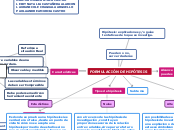Lo teórico y lo práctico.
To name your story, you have to think about the overall message and what you want your audience to understand from the story. Also, make it relevant and easy to remember.
Investigacion educativa.
Cientifica
Desarrollar una comprensión más refinada de sus propios problemas y prácticas.
Las observaciones, las interpretaciones y los juicios, adquieran mayor grado de objetividad científica.
Eliminar las inadecuaciones de las creencias.
Procedimientos de investigación.
Organizar para trasformar los problemas educacionales en una serie de cuestiones teóricas formales.
Demostrar una teoría o creencia como verdad absoluta es al mismo tiempo erróneo y acientífico.
Relación teoría-práctica.
Incorporación de la teoría a la práctica
Como teóricos no podrían producir teorías sin tener prácticas específicas de su actividad.
Los maestros como prácticos no podrían enseñar sin una cierta medida de reflexión acerca de lo que hacen.
Teorías=actividad práctica.
Poseer alguna teoría previa de la educación que estructure actividades y guié sus decisiones.
Los profesores no podrían practicar si no tuviesen conocimiento de la situación.
Finalidad.
The ending of a story is essential. We all know that if the ending is weak, what happened before loses its importance. So make it unpredictable, but fair. A resolved ending answers all the questions and ties up any loose threads from the plot.
No dirigirse.
This is the closure section of the story.
See examples of possible outcomes below:
- all problems have been solved
- it's clear how each one of your characters ends up
- your main character is transformed by the challenge
Trasformar los problemas de la educación en problemas teóricos distorsiona su finalidad y la naturaleza.
Descuidar o ignorar la naturaleza practica de los problemas de la educación.
Try answering these questions to come up with a closure:
- Have all the problems been solved?
- Is there a clear picture of what happens with each character in the story?
- Has the challenge transformed your main character?
- How do the characters feel in the end?
Dirigirse.
This is the moment when the main character surpasses the last obstacle and finally faces their greatest challenge.
The climax usually follows one of these patterns:
- realization
- resolution
- choice
Type in your answer.
Mejorar la práctica de la educación.
Resolver problemas educacionales.
Actividades.
The middle of the story is where you add layers of complications that will lead to the end. Reveal more about the character's journey. Did their personality go through changes? How did they overcome the challenges? And as you build up the story’s central conflict, make it more personal to that character. Also, from the middle act, you have to lead into the final act.
Prácticas.
Your character(s) need(s) motivation in order to solve the challenge(s).
Su finalidad general es producir un cambio.
Why does your character need to confront this challenge? What does he/she expect to accomplish by solving it?
See a few examples:
- will marry in 3 days
- can fix the mistakes of the past
Estudio de la enseñanza.
Estudio de la agricultura.
Teóricas.
Each story has a main character and that character usually needs to solve a problem or challenge. The character's challenge is the one that creates tension throughout the story.
Su finalidad es poder descubrir la verdad.
In most stories, there are 3 challenges. The number 3 is a mystical number symbolizing completeness. Try to come up with interesting challenges with which your character needs to struggle.
See a few examples below:
- turns into a werewolf at night
- is sent back in time
Estudio de la psicológica.
Estudio de la física.
Ciencia de la educación.
In the beginning of the story (or the exposition), you will need to introduce the setting and characters. You might also want to introduce the main conflict. This part of the story is important because it gives the reader necessary background information and maybe even a first insight into a character’s personality.
Segunda idea.
Determina rasgos distintivamente educativos de la investigación.
Conexión intrínseca entre la investigación y la concepción existente.
Elidir cuestiones de una actividad investigadora.
Primera idea.
The setting (time & place) of a story can change throughout the plot.
Resolver con eficacia los problemas cotidianos.
Sensory details include sight, sound, touch, smell, and taste. These details are important because they create depth in your setting.
See a few examples below:
- the smell of fresh bread
- the scent of freshly cut grass
- rain falling onto the windshield etc.
Desarrollar conocimientos teóricos.
The weather is an important element in your story because it can highly influence the ambiance and the mood of the characters.
Se adhiere a un modo de vida comunitario.
The time of the story can also change. It can describe the event of a single day or can include an entire year's plot. Anyway, don't forget to mention it.
Campo concreto de indagación.
Your story can take place wherever your imagination will take you to.
For example: in an elevator, in an enchanted forest, etc. Don't forget to give details of the environment each time the setting changes, otherwise, the story can be confusing. Also, mention the seasons as each of them has unique weather and events.










